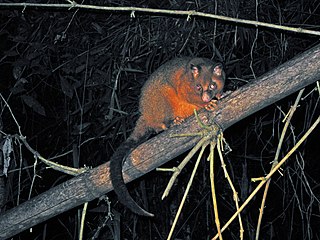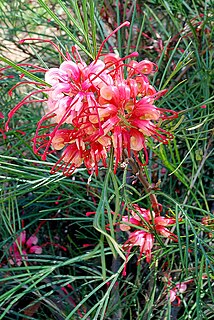Typhlacontias is a genus of legless, burrowing skinks in the family Scincidae, a genus endemic to Sub-Saharan Africa. Its sister group is the clade consisting of the genera Feylinia and Melanoseps.

The southern cassowary, also known as double-wattled cassowary, Australian cassowary or two-wattled cassowary, is a large flightless black bird. It is one of the three living species of cassowary, alongside the dwarf cassowary and the northern cassowary. It is a ratite and therefore related to the emu, ostriches, rheas and kiwis.
Androstachys johnsonii, the Lebombo ironwood, is a medium-sized Afrotropical tree species, and the sole member of the genus Androstachys in the Picrodendraceae. It is slow-growing, evergreen to deciduous, and dioecious, with flowers that are wind-pollinated. It is native to southeastern Africa and Madagascar, where it generally occurs gregariously on rocky hillsides, particularly in hot and dry situations. It produces a hard, durable wood which is of economic interest. Its specific name commemorates W. H. Johnson, a 19th-century Director of Agriculture in Mozambique. Four related species which are native to Madagascar, are usually placed in genus Stachyandra.

Elingamita is a genus in the plant family Primulaceae. It consists of a single species, Elingamita johnsonii, a tree or shrub endemic to the Three Kings Islands approximately 55 km north of the North Island of New Zealand. The entire world natural population of the tree is confined to a small rocky island and two nearby islets, and thus is vulnerable to destruction by fire or other unforeseen events. Elingamita johnsonii grows as a shrub or small tree in pohutukawa forest and coastal scrub on West island. It also occurs on two rocky islets of the Princes Group; on one of these islets, Hinemoa Rock, it grows as an emergent canopy tree in exposed places. The relationship of Elingamita to other genera of the Primulaceae remains to be properly established. Discovered in 1950, Elingamita johnsonii takes its name from the steamer Elingamite, which was wrecked on West Island in 1902. The natural range is currently free of rodents, but the fruit is known to be very palatable to rats.
Ixora johnsonii is a species of flowering plant in the family Rubiaceae. It is endemic to Ernakulam in the state of Kerala, India.

Macrozamia johnsonii is a species of cycad in the family Zamiaceae. It is endemic to New South Wales, Australia.

Melanocetus johnsonii is a species of black seadevils in the family of Melanocetidae, which means "black whale" in Greek. The species is named after James Yate Johnson, the English naturalist who discovered the first specimen in Madeira in 1863. The common names include anglerfish, viperfish and fangtoothfish.

The coppery brushtail possum is a species of marsupial possum in the family Phalangeridae. Coppery brushtails are found within the Atherton Tablelands area of Queensland, in northeastern Australia. These mammals inhabit rainforest ecosystems, living within the tree canopy. Though they have a restricted distribution, they are locally common. This population is often considered a subspecies of T. vulpecula.

Grevillea johnsonii, commonly known as Johnson's grevillea or Johnson's spider flower, is a species of flowering plant in the family Proteaceae and is endemic to New South Wales. It is a shrub with divided, needle-like leaves and red to orange flowers, and grows in rocky places.

Corylus johnsonii is an extinct species of hazel known from fossil fruits found in the Klondike Mountain Formation deposits of northern Washington state, dated to the early Eocene Ypresian stage. Based on described features, C. johnsonii is the oldest definite species in the genus Corylus.

Lactobacillus johnsonii is a species in the genus Lactobacillus identified in 1980 by John L. Johnson, an American microbiologist and his associates. Its type strain is ATCC 33200. It is part of the healthy vaginal microbiota and has been identified as having probiotic properties. The L. johnsonii strain La1 was one of the first cultures to be proposed as a probiotic dairy supplement in 1995 at the Nestlé Research Center, Lausanne. Although yeast and bacteria have been used in dairy products for fermenting purposes for centuries, the investigation and choice of a microorganism as a fermenting agent based on its health benefits was novel at the time. Today the probiotic culture is used in the LC1 yogurt products by Nestlé.
Typhlacontias brevipes, also known as the FitzSimon's [sic] burrowing skink or short blind dart skink, is a skink species endemic to the Namib Desert (Namibia). It was described by Vivian FitzSimons in 1938.

Acacia johnsonii, commonly known as gereera wattle or geereva wattle, is a shrub belonging to the genus Acacia and the subgenus Phyllodineae that is native to parts of eastern Australia.
Elaeocarpus johnsonii, commonly known as Kuranda quandong or Johnson's quandong, is species of flowering plant in the family Elaeocarpaceae and is endemic to north-east Queensland. It is a small to medium-sized tree, often with several main stems, elliptic to egg-shaped leaves with the narrower end towards the base, racemes of up to seven flowers, the petals with fringed lobes, and dark blue fruit.
Typhlacontias gracilis, Roux's blind dart skink, is a species of lizard which is found in Namibia, Zimbabwe, Botswana, and Zambia.
Typhlacontias kataviensis, the Katavi blind dart skink, is a species of lizard which is endemic to Tanzania.
Typhlacontias rudebecki, Rudebeck's western burrowing skink, is a species of lizard which is endemic to Angola.
Notelaea johnsonii, also known as the veinless mock olive, is a species of flowering plant in the olive family that is endemic to Australia.









